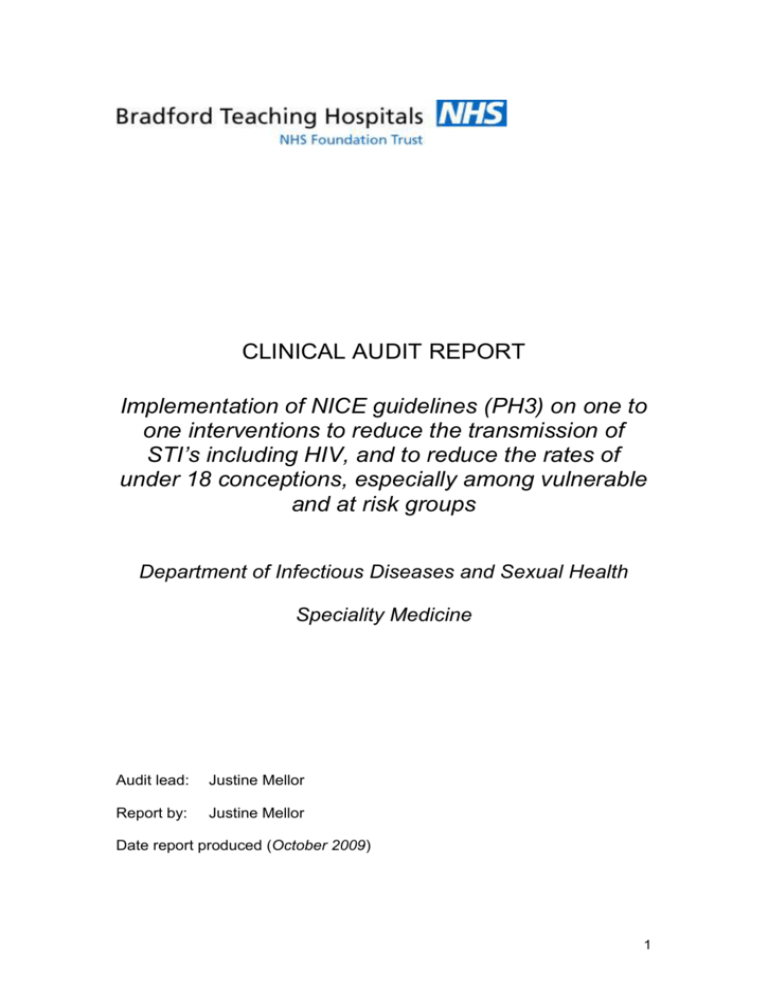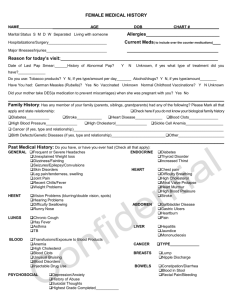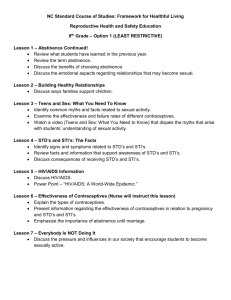
CLINICAL AUDIT REPORT
Implementation of NICE guidelines (PH3) on one to
one interventions to reduce the transmission of
STI’s including HIV, and to reduce the rates of
under 18 conceptions, especially among vulnerable
and at risk groups
Department of Infectious Diseases and Sexual Health
Speciality Medicine
Audit lead:
Justine Mellor
Report by:
Justine Mellor
Date report produced (October 2009)
1
Contents
Page
Executive summary
3
Background
3
Aim of the audit
4
Criteria and standards
4
Methodology
4
Results
4
Discussion
6
Conclusion
7
Recommendations
7
References
8
Acknowledgements
8
Appendices
9
2
Executive summary
This audit was completed by the staff at the Trinity centre to determine whether the
service is implementing, and is in compliance with, the NICE public health
intervention guidance “One to one interventions to reduce the transmission of
sexually transmitted infections (STI’s) including HIV, and to reduce the rate of under
18 conceptions, especially among vulnerable and at risk groups”.
The NICE audit template and criteria have been applied and findings reveal that the
recommendations are partially been adhered to and are further explained in the
results section of this report. Where standards are below those set by the NICE audit
criteria, recommendations have been outlined to implement into future practice.
Background
The National Strategy for Sexual Health and HIV ( DoH 2001) set national targets for
reducing newly acquired HIV infections, gonorrhoea infections and unwanted
pregnancies.
However, diagnosis of sexually transmitted infections continue to increase, most
alarmingly among young people, some black and minority ethnic groups, and gay
men (DoH 2008). Little is known about changes in behaviour since the publication of
the strategy, although indicators of sexual ill-health and recent surveys among
different population groups suggest risk behaviour is continuing. One third of young
people report inconsistent condom use (ONS 2007) and almost half of gay men
report an episode of unprotected anal intercourse in the preceding year
(Weatherburn et al 2008). Frequent use of alcohol and other drugs is associated with
higher numbers of sexual partners and decreased likelihood of using protection.
(Bellis 2007)
In 2001 the National Strategy stated that the evidence base for HIV and STI
prevention was still dispersed and unsystematic and effective interventions hadn’t
been agreed. Since then the National Institute for Health and Clinical Excellence
completed a review of the literature and in 2007 the public health intervention
guidance 3 was published. The guidance presents the recommendations on “One to
one interventions to reduce the transmission of sexually transmitted infections (STI’s)
including HIV, and to reduce the rate of under 18 conceptions, especially among
vulnerable and at risk groups. One to one interventions are an important element of
3
modern sexual health services and should be integral to the routine care provided by
both primary care, contraceptive and sexual health services.
Aim of the audit
The aim of the audit is to determine if the Trinity Centre is implementing, and in
compliance with the NICE public health intervention guidance “One to one
interventions to reduce the transmission of sexually transmitted infections (STI’s)
including HIV, and to reduce the rate of under 18 conceptions, especially among
vulnerable and at risk groups.
Criteria and standards
Criteria and standards set by NICE public health intervention guidance 3 (April 2007)
were used. Please see appendix.
For Partner Notification, outcomes are measured against the current British
Association of Sexual Health and HIV (BASHH) guidelines of 0.64 contacts verified
as attended and screened per index patient.
Methodology
A retrospective case note review was done for a two and a half month period from
June to September 2009. A clinic sheet of all new and reregistered patients attending
during this time period was printed off by reception staff and all case notes were
reviewed by Health Advising and Nursing staff to audit against the NICE criteria.
Results
New and reregistered patients n=1969 case notes were reviewed between
June and September 2009.
Criteria 1 – The percentage of patients that, during an appropriate
consultation, have had the risk of an STI assessed by a health
professional. All 1969 patients had completed risk assessment sheets
(100%)
Criteria 2 – The percentage of individuals, identified as being at high
risk of STI’s, who have had arrangements made for a one to one
structured discussion to take place with a health professional.
74 patients were identified to be high risk falling into the following categories
as identified by NICE recommendations 1 and 2.
Men who have sex with men (unprotected)
Risk behaviour associated with drug and/or alcohol misuse
4
People who have come from or who have visited areas of HIV prevalence
Early onset of sexual activity
Unprotected sex and frequent change of and/or multiple sexual partners.
Outcome - n= 50/74 (68%) patients had arrangements made for one to one
structured discussions.
Criteria 3 – The percentage of such one to one structured discussions
(with individuals at high risk of STI’s) that are structured on the basis of
behaviour change theories.
Outcome = 31/50 (62%) of patients seen.
Total Number
Referred for 1:1 discussion
1:1 structured on behaviour change theory
30
25
20
15
10
5
0
27
22
12
15
13
9
12
7
9
7
1
MSM
22
>partners/frequent
change
endemic area
alcohol/sustance
misuse
Criteria 4 – The percentage of patients with an STI whose partner(s)
have been tested and, where necessary, treated by the health
professional or agency making the original diagnosis.
Outcome – From case note review there were 227 diagnosis of STI’s which
warranted partner notification. Out of these 174 sexual contacts were
confirmed as being screened and treated where necessary - 76%
Criteria 5 – The percentage of patients with an STI whose partner(s)
have been referred to a specialist with responsibility for partner
notification.
Outcome – This is not applicable to our service as we have trained Sexual
Health Advisers to complete partner notification so no onward referral is
necessary.
Criteria 6 – The percentage of patients with an STI who have been
provided with infection specific information, including advice about
possible re-infection, for partners and themselves.
Outcome – 132 patients out of 227 had the above standard documented in
their client records at case note review – 58%
5
Number of cases
No of partners seen
Infection-Specific Information
180
200
134
110
150
100
29 28
50
12
10 5
3
2
6
2
1
6
5
0
chlamydia
gonorrhoea
TV
HIV
Syphilis
Criteria 7 – The percentage of young people aged 18 who, having been
identified as vulnerable, have been provided with one to one sexual
health advice by a health professional.
Outcome – 9 young people were identified as vulnerable and 8 of these had been
provided with one to one sexual health advice – 89%
Criteria 8 – The percentage of young people aged under 18 who, having
been identified as vulnerable, have been provided with supporting
information on sexual health, in a format accessible to the recipient.
Outcome –6 out of 9 young people received supporting information – 66%
Num ber
One to one sexual health advice
4
given supporting inform ation
3
3
2
2
2
3
2
2
1
3
2
1
1
1
1
0
aged 14
aged 15
aged 16
aged 17
Criteria 9 and 10 were not audited as these are directed towards
midwifery services and PCT’s.
Discussion
Criteria 2.
There was no documentation recorded to the reasons why identified high risk clients
were not referred for one to one discussions in patient records.
Interestingly, for MSM and patients or sexual contacts from high endemic areas had
a higher rate of referral (78%) than for multiple partners and alcohol/substance
misuse (55%). This may be because historically MSM and patients from HIV endemic
areas are routinely referred to the Health Advisors for pre-test discussions for HIV. In
contrast, referral for motivational interviewing for multiple partners and for patients
with risk taking behaviour in association with alcohol/drug misuse is relatively new so
this may be suggestive of why these referrals were lower.
6
Criteria 3.
MSM and clients from high endemic areas had documented evidence of one to one
interventions based on behaviour change theories in 45% of referrals.
The documentation implies that often these clients have other requirements which
become the focus of the consultation as opposed to motivational interviewing. Such
requirements were assessment for Post Exposure Prophylaxis (PEP), pre-test
discussion around HIV in clients who were contacts or had a particular high risk
episode and partner notification.
Where patients were referred for one to one interventions due to alcohol/substance
misuse and multiple or frequent change of partners, 84% had discussions based on
behaviour change theory. This rate was higher than the previous 2 groups as often
condom use was the main focus of the consultation. The remaining 16% of this group
had either declined to see another practitioner for further discussion or left without
waiting to see another practitioner.
Conclusions
The Trinity Centre implemented the NICE guidelines on One to One interventions to
reduce the transmission of sexually transmitted infections including HIV from June
2009.
The audit revealed that 100% of patients attending are having a complete sexual
health risk assessment at initial consultation. However, once identified as being high
risk, not all patients are currently having arrangements made for a one to one
interview based on behaviour change theory.
All patients with a diagnosed STI have had arrangements made for Partner
Notification and outcomes exceed the standards set by the British association of
sexual health and HIV (BASHH).
All patients under the age of 18 are having a detailed risk assessment in accordance
with local safeguarding children guidelines and 8 out of the 9 young people identified
had evidence of one to one sexual health advice documented in their records.
Recommendations
As this was the initial audit at the Trinity Centre it has provided a baseline
assessment of current practice from which future audits can now be measured.
To assist with this and improve standards the following recommendations are made:
Introduce a local Motivational Interviewing code for KC60/GUMCAD
Improve documentation in patient records by Health Advisors by
implementing a MI record sheet to record one to one intervention.
Provide information packs for vulnerable young people with local details
around emergency contraception and CASH services and safer sex literature.
Practitioners using MI skills should have monthly supervision with psychology
to ensure good practice and comply with clinical governance.
7
Consider further practitioners to complete training in MI skills to improve
patient flow in department by reducing onward referral.
Re-audit in 12 months to be completed.
References
Bellis, M in Independent Advisory group on Sexual health and HIV (2007) Sex, drugs,
alcohol and young people: a review of the impact drugs and alcohol have on young
peoples sexual behaviour. Seminar findings.
Department of Health (2001). National Strategy for Sexual Health and HIV DoH
2001.
Department of Health (2008) Progress and Priorities – Working together for High
Quality Sexual health. Review of the National Strategy for Sexual Health and HIV.
DoH 2008
ONS (2007) National Statistics Omnibus Survey Contraception and Sexual health
2006/7. Office for National Statistics.
Acknowledgements
Reception staff for printing clinic lists throughout the audit and providing case notes
for review.
Nursing staff that assisted with the audit during their coding sessions.
Health Advising Team for their support and input during the audit period.
8
Appendices
Prevention of sexually transmitted infections and under 18 conceptions NICE public health intervention guidance 3
Audit criteria: These are the audit criteria developed by NICE to support the implementation of this guidance. Users can cut and paste these
into their own programmes or they can use this template
Criterion
no.
Criterion
Exceptions
Definition of terms and/or
general guidance
Data sources
1
The percentage of patients that, during an
appropriate consultation, have had the risk of an
STI assessed by a health professional.
None
An appropriate consultation is
defined as one:
- relating to contraception,
pregnancy or abortion
- offering an STI test
- carrying out a cervical smear
test
- providing travel immunisation
- where routine care can
reasonably include a discussion
on sexual behaviour.
Patient records
[Acute trusts (GUM clinics)/PCTs]
Standard = 100%
9
Criterion
no.
Criterion
Exceptions
Definition of terms and/or
general guidance
Data sources
2
The percentage of individuals, identified as being
at high risk of STIs, who have had arrangements
made for a one to one structured discussion to
take place with a health professional.
Individuals identified
as not being at high
risk of an STI
‘High risk’ is defined in the
description of the target
population in recommendation 1
and 2 of the guidance.
Patient records
The discussion may be arranged
either with the health
professional identifying the risk (if
trained in sexual health), or with
a trained practitioner to whom
the individual has been referred.
[Acute trusts (GUM clinics)/PCTs]
3
The percentage of such one to one structured
discussions (with individuals at high risk of STIs)
that are structured on the basis of behaviour
change theories.
Standard = 100%
Individuals identified
as not being at high
risk of an STI
‘High risk’ is defined in the
description of the target
population in recommendation 1
and 2 of the guidance.
Patient records, or patient
administration systems
Reference to a range of
behaviour change theories can
be found in ‘Predicting health
behaviours’ (Conner and Norman
2005).
[Acute trusts (GUM clinics)/PCTs]
Standard = 100%
10
Criterion
no.
Criterion
Exceptions
Definition of terms and/or
general guidance
Data sources
4
The percentage of patients with an STI whose
partner(s) have been tested and, where
necessary, treated by the health professional or
agency making the original diagnosis.
When taken in
conjunction with
criterion 5, there
should be no
exceptions
Partner notification includes both
testing and treatment of
partners.
Patient administration systems
[Acute trusts (GUM clinics)/specialist
services/PCTs]
5
The percentage of patients with an STI whose
partner(s) have been referred to a specialist with
responsibility for partner notification.
[Acute trusts (GUM clinics)/specialist
services/PCTs]
6
The percentage of patients with an STI who have
been provided with infection specific information,
including advice about possible re-infection, for
partners and themselves.
Standard = X% (total standard
for criterion 4 and 5 = 100%)
When taken in
conjunction with
criterion 4, there
should be no
exceptions
The percentage of young people aged under 18
who, having been identified as vulnerable, have
been provided with one to one sexual health
advice by a health professional.
[Acute trusts (GUM clinics)/PCTs]
Partner notification includes both
testing and treatment of
partners.
Patient administration systems
Standard = X% (total standard
for criterion 4 and 5 = 100%)
None
[Acute trusts (GUM clinics)/specialist
services/PCTs]
7
It may be necessary to refer the
patient to a specialist with
responsibility for partner
notification (see criterion 5).
Patient records
Standard = 100%
Adults aged 18 and
over.
This criterion also
excludes young people
yet to be identified as
‘vulnerable’
See recommendation 5 of the
guidance for definitions of
‘vulnerable young people’ and
the range of sexual health advice
to be provided.
Patient records
Standard = 100%
11
Criterion
no.
Criterion
Exceptions
Definition of terms and/or
general guidance
Data sources
8
The percentage of young people aged under 18
who, having been identified as vulnerable, have
been provided with supporting information on
sexual health, in a format accessible to the
recipient.
Adults aged 18 and
over.
See recommendation 5 of the
guidance for definitions of
‘vulnerable young people’ and
the range of sexual health advice
to be provided.
Patient records
This criterion also
excludes young people
yet to be identified as
‘vulnerable’
[Acute trusts (GUM clinics)/PCTs]
9
The percentage of young women aged under 18
who are pregnant or already mothers and have
been identified as vulnerable – have discussed
with a health professional:
- how to prevent unwanted pregnancies
- how to prevent or get tested for STIs.
[Acute trusts (midwifery services)/PCTs]
Standard = 100%
Adults aged 18 and
over.
Young women aged
under 18 who are not
pregnant and who are
not already mothers;
this criterion also
excludes such young
women who are not
considered to be
‘vulnerable’ or have
yet to be identified as
such
See recommendation 6 of the
guidance for definitions of
‘vulnerable young women’ and
more details on the range of
sexual health and other advice to
be provided.
Patient records
Where appropriate such
discussions should take place
with the partner of the young
woman.
(Standard = 100% in each case)
12
Criterion
no.
Criterion
Exceptions
Definition of terms and/or
general guidance
Data sources
10
The percentage of young women aged under 18
who are pregnant or already mothers and have
been identified as vulnerable – have been
provided with supporting information on:
Adults aged 18 and
over.
See recommendation 6 of the
guidance for definitions of
‘vulnerable young women’ and
more details on the range of
sexual health and other advice to
be provided.
Patient records
- how to prevent unwanted pregnancies
- how to prevent or get tested for STIs
in a format accessible to the recipient.
(Acute trusts (midwifery services)/PCTs)
No. of
criterion
replaced
Young women aged
under 18 who are not
pregnant and who are
not already mothers;
this criterion also
excludes such young
women who are not
considered to be
‘vulnerable’ or have
yet to be identified as
such
(Standard = 100% in each case)
Local alternatives to above criteria (to be used where
other data addressing the same issue are more readily
available)
13








